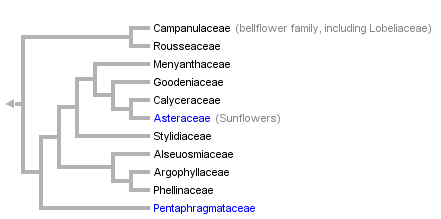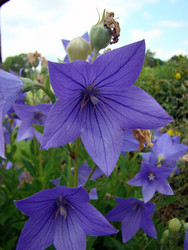Asterales



This tree diagram shows the relationships between several groups of organisms.
The root of the current tree connects the organisms featured in this tree to their containing group and the rest of the Tree of Life. The basal branching point in the tree represents the ancestor of the other groups in the tree. This ancestor diversified over time into several descendent subgroups, which are represented as internal nodes and terminal taxa to the right.

You can click on the root to travel down the Tree of Life all the way to the root of all Life, and you can click on the names of descendent subgroups to travel up the Tree of Life all the way to individual species.
For more information on ToL tree formatting, please see Interpreting the Tree or Classification. To learn more about phylogenetic trees, please visit our Phylogenetic Biology pages.
close boxReferences
Albach, D. C., P. S. Soltis, D. E. Soltis, and R. G. Olmstead. 2001. Phylogenetic analysis of asterids based on sequences of four genes. Annals of the Missouri Botanical Garden 88:163-212.
Backlund, A. and B. Bremer. 1997. Phylogeny of Asteridae s. str. based on rbcL sequences, with particular reference to Dipsacales. Plant Systematics and Evolution 207:225-254.
Bremer, K. 1994. Asteraceae: Cladistics and Classification. Timber Press, Portland, Oregon.
Bremer, K., A. Backlund, B. Sennblad, U. Swenson, K. Andreasen, M. Hjertson, J. Lundberg, M. Backlund, and B. Bremer. 2001. A phylogenetic analysis of 100+ genera and 50+ families of euasterids based on morphological and molecular data with notes on possible higher level morphological synapomorphies. Plant Systematics and Evolution 229:137-169.
Bremer, B., K. Bremer, N. Heidari, P. Erixon, R. G. Olmstead, A. A. Anderberg, M. Källersjö, and E. Barkhordarian. 2002. Phylogenetics of asterids based on 3 coding and 3 non-coding chloroplast DNA markers and the utility of non-coding DNA at higher taxonomic levels. Molecular Phylogenetics and Evolution 24:274-301.
Bremer, K. and M. H. G. Gustafsson. 1997. East Gondwana ancestry of the sunflower alliance of families. Proceedings of the National Academy of Sciences (USA) 94:9188-9190.
Gustafsson, M. H. G., A. Backlund, and B. Bremer. 1996. Phylogeny of the Asterales sensu late based on rbcL sequences with particular reference to the Goodeniaceae. Plant Systematics and Evolution 199:217-242.
Gustafsson, M. H. G. and K. Bremer. 1995. Morphology and Phylogenetic Interrelationships of the Asteraceae, Calyceraceae, Campanulaceae, Goodeniaceae, and Related Families (Asterales). American Journal of Botany 82:250-265.
Karehed, J., J. Lundberg, B. Bremer, and K. Bremer. 1999. Evolution of the Australasian families Alseuosmiaceae, Argophyllaceae, and Phellinaceae. Systematic Botany 24:660-682.
Lammers, T. G. 1992. Circumscription and phylogeny of the Campanulales. Annals of the Missouri Botanical Garden 79:388-413.
Lundberg, J. 2001. The asteralean affinity of the Mauritian Roussea (Rousseaceae). Botanical Journal of the Linnean Society 137:267-276.
Lundberg J. and K. Bremer. 2003. A phylogenetic study of the order Asterales using one morphological and three molecular data sets. International Journal of Plant Science 164:553-578.
Olmstead, R. G., K.-J. Kim, R. K. Jansen, and S. J. Wagstaff. 2000. The phylogeny of the Asteridae sensu lato based on chloroplast ndhF gene sequences. Molecular Phylogenetics and Evolution 16:96-112.
Savolainen, V., M. F. Fay, D. C. Albach, A. Backlund, M. van der Bank, K. M. Cameron, S. A. Johnson, M. D. Lledó, J.-C. Pintaud, M. Powell, M. C. Sheahan, D. E. Soltis, P. S. Soltis, P. Weston, W. M. Whitten, K. J. Wurdack, and M. W. Chase. 2000. Phylogeny of the eudicots: a nearly complete familial analysis based on rbcl gene sequences. Kew Bulletin 55:257-309.
Soltis, D. E., P. S. Soltis, M. W. Chase, M. E. Mort, D. C. Albach, M. Zanis, V. Savolainen, W. H. Hahn, S. B. Hoot, M. F. Fay, M. Axtell, S. M. Swensen, L. M. Prince, W. J. Kress, K. C. Nixon, and J. S. Farris. 2000. Angiosperm phylogeny inferred from 18S rDNA, rbcL, and atpB sequences. Botanical Journal of the Linnean Society 133:381-461.
Tank, D. C. and M. J. Donoghue. 2010. Phylogeny and phylogenetic nomenclature of the Campanulidae based on an expanded sample of genes and taxa. Systematic Botany 35:425-441.
Tobe, H. and N. R. Morin. 1996. Embryology and circumscription of Campanulaceae and Campanulales: A review of literature. Journal of Plant Research 109:425-435.
Title Illustrations

| Scientific Name | Platycodon grandiflorus |
|---|---|
| Location | cultivated |
| Specimen Condition | Live Specimen |
| Source | Platycodon grandiflorus, Balloon Flower, Chinese Bellflower |
| Source Collection | Flickr |
| Image Use |
 This media file is licensed under the Creative Commons Attribution-NonCommercial-NoDerivs License - Version 2.0. This media file is licensed under the Creative Commons Attribution-NonCommercial-NoDerivs License - Version 2.0.
|
| Copyright | © 2008 Olaf |
| Scientific Name | Corokia cotoneaster |
|---|---|
| Location | cultivated, Royal Botanic Gardens, Kew, UK |
| Specimen Condition | Live Specimen |
| Source | Corokia cotoneaster |
| Source Collection | Flickr |
| Image Use |
 This media file is licensed under the Creative Commons Attribution License - Version 2.0. This media file is licensed under the Creative Commons Attribution License - Version 2.0.
|
| Copyright | © 2007 Scott Zona |
| Scientific Name | Symphyotrichum ericoides |
|---|---|
| Location | Washington County, Minnesota, USA |
| Specimen Condition | Live Specimen |
| Source | Symphyotrichum ericoides |
| Source Collection | Flickr |
| Copyright | © 2008 squamatologist |
About This Page
Correspondence regarding this page should be directed to Jose L. Panero at
Page copyright © 2010
 Page: Tree of Life
Asterales.
The TEXT of this page is licensed under the
Creative Commons Attribution-NonCommercial License - Version 3.0. Note that images and other media
featured on this page are each governed by their own license, and they may or may not be available
for reuse. Click on an image or a media link to access the media data window, which provides the
relevant licensing information. For the general terms and conditions of ToL material reuse and
redistribution, please see the Tree of Life Copyright
Policies.
Page: Tree of Life
Asterales.
The TEXT of this page is licensed under the
Creative Commons Attribution-NonCommercial License - Version 3.0. Note that images and other media
featured on this page are each governed by their own license, and they may or may not be available
for reuse. Click on an image or a media link to access the media data window, which provides the
relevant licensing information. For the general terms and conditions of ToL material reuse and
redistribution, please see the Tree of Life Copyright
Policies.
- Content changed 17 July 2010
Citing this page:
Tree of Life Web Project. 2010. Asterales. Version 17 July 2010 (temporary). http://tolweb.org/Asterales/20736/2010.07.17 in The Tree of Life Web Project, http://tolweb.org/











 Go to quick links
Go to quick search
Go to navigation for this section of the ToL site
Go to detailed links for the ToL site
Go to quick links
Go to quick search
Go to navigation for this section of the ToL site
Go to detailed links for the ToL site